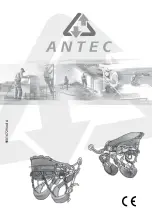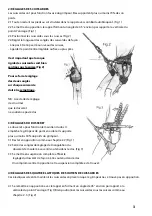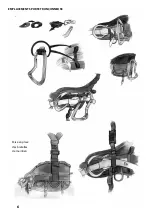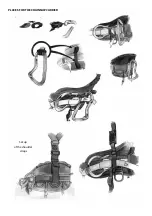
2/ AdjUSTMENTS oF ThE LEG STRApS
The leg straps’ function is the course of the climber.They withstand more or less 70%of his weight.
2.1 Keeping feet on the ground, settle in the abseil with its self-jamming hitch (Fig 1).
2.2 Place oneself in a layback position; the abseil making an angle of about 45° in relation to the
vertical of the anchorage point (Fig 1).
2.3 Position the legs straps under the thighs (Fig 2).
2.4 Adjust the length of the straps of the leg straps in order:
- not to be too tight on the thighs,
- to keep the central point adjustable or fixed at the nearest.
It is important for the rigid shell
of the leg straps to be well
centered under the thigh (Fig 2).
For that, the adjustment
of the two straps
on each leg strap must be
symmetrical.
NB: At this stage of the adjustment,
it is right for the back
not to be maintained
by the back support.
3/ AdjUSTMENTS oF ThE BACk SUppoRT
The function of the back support is to maintain the back. It
prevents the climber from faling backwards. It withstands
more or less 30%of the climber’s weight.
3.1 Stay in a layback position as in the section 2.2 (Fig 1)
3.2 Tighten the back support’s triangulation adjustment
straps in order to feel maintained in the back. (Fig 3)
3.3 Place oneself in complete suspension; refine the
back support adjustment in order to be maintained in the
back. A compromise between the layback and the
complete suspension must be found.
4/ AdjUSTMENTS oF ThE FoUR ELASTICS MAINTAINING ThE LEG STRApS
The function of these elastics is to maintain the leg straps in place when the climber is not in a layback
position.
4.1 Once again, place oneself in a layback position with the abseil making an angle of about 45°
in relation to the vertical of the anchorage point (Fig 1). Position the legs straps under the thighs
as in the section 2.3 (Fig 2).






























